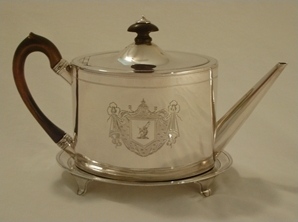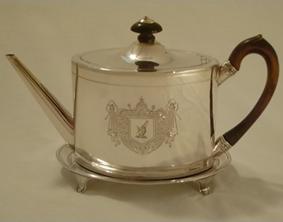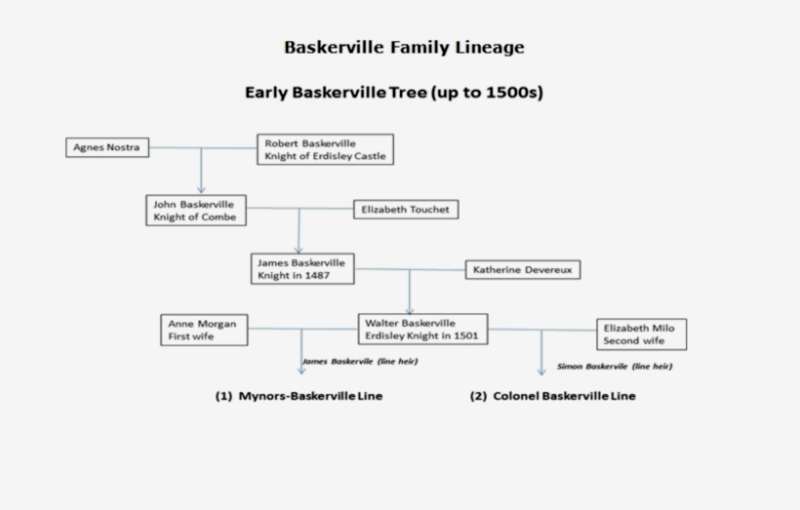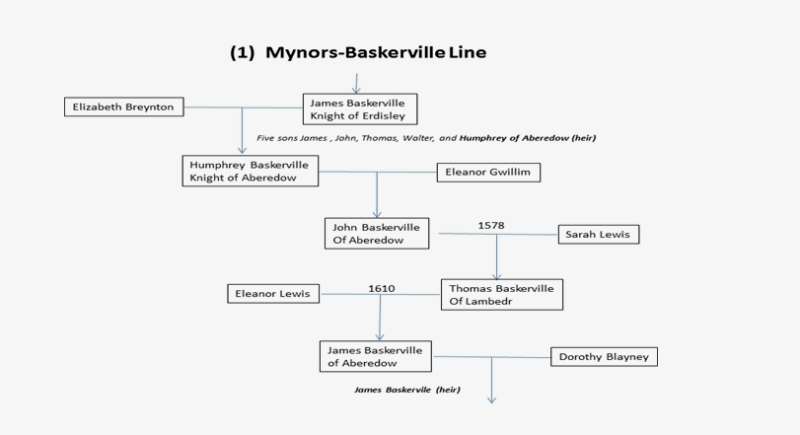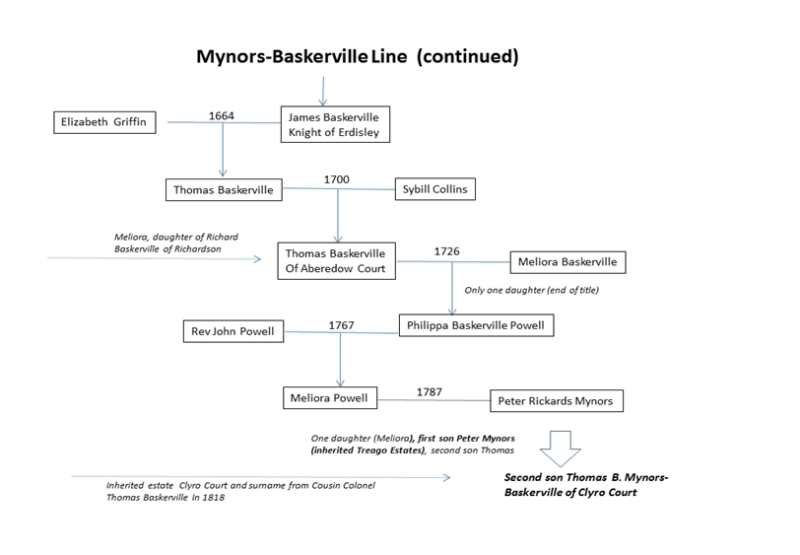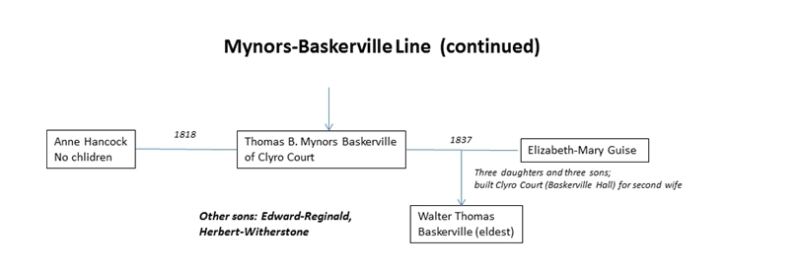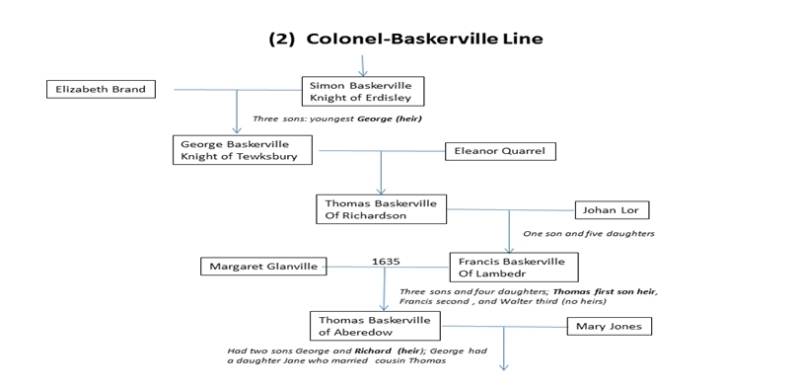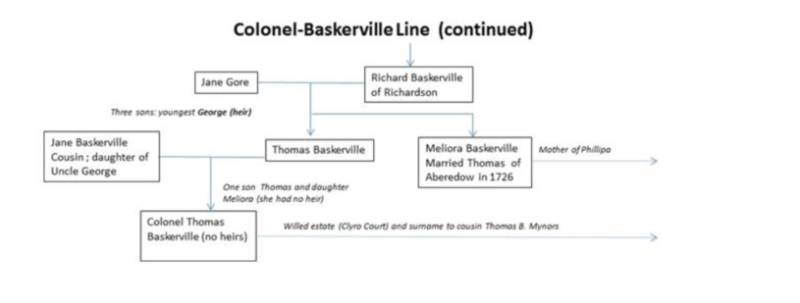by Joanne and
Emmett Eldred
(click on photos to enlarge image)
OUR ADVENTURE WITH SHERLOCK HOLMES
Last year we were able to purchase a George III teapot &
matching stand, which was made by Henry Chawner in 1791. After
receiving it we became intrigued to learn more about the piece
and especially the unusual family crest which was engraved in
the cartouches on both sides of the teapot and also on the
stand.
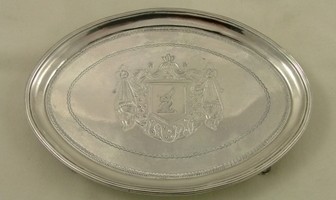
Teapot & stand by Henry Chawner, London 1791
|
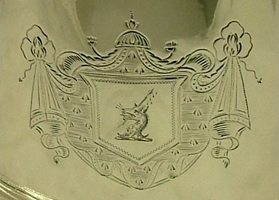
.
|
As noted in one of our previous articles (see at
http://www.ascasonline.org/WINDOWLUGL86.html), we have a set
of criteria by which we judge each of our purchases, and one of
our first checks is to confirm that the teapot & stand are an
original pair. A quick look at the hallmarks confirmed that both
the teapot & stand were made by Henry Chawner in 1791.
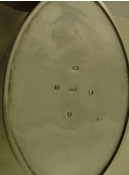
Teapot hallmarks
|
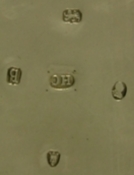
.
|

Stand hallmarks
|

.
|
The condition of the engravings was excellent and rated a 9
on our scale of 10. The teapot’s only flaws were a slight crack
and small chip in its finial and a very small ding at its base
on the left side. There were no visible repairs and the hinge
was in good condition.
Our interest next turned to the cartouches and the family crest
engraved in each of them.
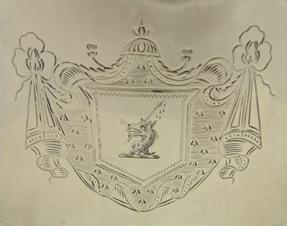
Right side of teapot
|
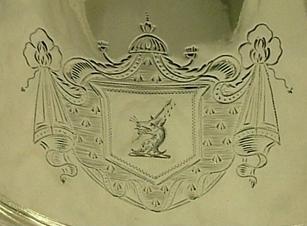
Left side of teapot
|
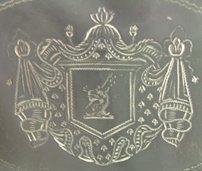
Stand engraving
|
The first question that arose was whether the cartouche and
crest engravings were contemporary with the pieces or added at a
much later date. Since many of the cartouche designs were used
well into the 20th century we have found the best way to
determine if they might have been engraved contemporaneously is
to look at other pieces from the maker and check for similarity.
In the case, we have found several other instances of the same
cartouche being used by Henry Chawner (and others) at around the
same time (1790-1792). Therefore we concluded that someone in
Chawner’s shop likely did, or contracted out, the engraving. The
three examples pictured below helped support that conclusion.
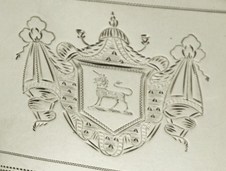
T. Graham & J Willis 1791
(tea caddy)
|
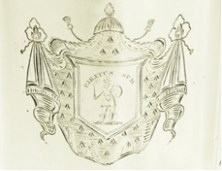
Henry Chawner 1790
(teapot and stand)
|
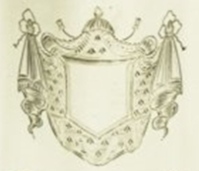
Henry Chawner 1791
(teapot)
|
As for the crest, it was hard to say upon initial
examination whether it was added at the same time as the
cartouche or a bit later. However that question quickly became
secondary to exploring the origins of the unusual crest, which
depicted a dog or wolf’s head holding what looked like a broken
spear in its mouth.
In true Sherlock Holmes fashion we tried to approach things
logically. Having some understanding of heraldic blazon, we
tried to translate the crest into blazon as best we could. The
head was clearly "erased" (i.e., head with curling neck fur, as
if torn or hacked from the body, rather than being cleanly cut).
It also appeared there were some drops at the end of the spear,
which we figure could possibly be blood. Our first attempt at
translation was "a wolf's head erased, holding in its mouth a
broken spear" (we omitted the drops since we were not sure how
to describe them). Being the crest was engraved on silver, we
did not include any reference to colors in our description.
Armed with our rough translation we immediately searched the
phrase in an electronic copy of John Burke's, Genealogical
History of the Landed Gentry, Volume 1. To our surprise we
had a hit on our first attempt. Burke described the Baskerville
family crest as "A wolf's head, erased, arg., holding in its
mouth a broken spear, staff, or., head arg., imbued, gu." Since
imbued means "stained with blood", we figured our original
speculation might be correct and the drops were indeed drops of
blood.
Excited by our early success, we began to aggressive research
the Baskerville family (we also began feeling closer to Sherlock
since one of his most famous cases involved the "Hound of the
Baskervilles"). Fortunately, we almost immediately discovered an
article on "Early Baskerville Family History" by Brian Erwin and
edited by Peter Baskerville Rance (1990).
This article describes the family's history up until around 1600
and reading it made us keenly aware that the Baskervilles were
an old a distinguished British family.
"The Baskervilles have a truly royal ancestry, and their
pedigree, which has been authentically deduced and duly
registered in the College of Arms, is a large one. Burke writes
of the family as 'one of the most ancient and honorable in
England'. Their connection with Herefordshire began with the
ancestor who came over to help William the Conqueror, from
Normandy. Erdisley or Eardisley was the Herefordshire stronghold
of the Baskervilles, called 'Herdeleg'' in the Domesday Survey.
The castle of those days stood in a forest, of which it is said
the great oak of Eardisley, was still standing in 1907. The
first Baskerville (died 1109) who is mentioned as living in
Eardisley castle, about forty-three years after the Conquest,
was one Robert, a knight, whose wife Agnes, was daughter and
heiress of Nasta, daughter of Rees ap Griffiths, Prince of South
Wales."
However, what really perked our interest was the following
description:
"There are many Baskerville arms but those given to the Hereford
line are appropriate to a family who have lived so much on the
border of Wales and are now residing in the Principality. The
crest is a wolf's head erased holding in its mouth a broken
spear with five drops of blood. In 'olden times' wolves were
hunted in Wales to exterminate them and no doubt some brave act
of saving life from a wolf's clutches may have given rise to
this heraldic cognizance."
It appeared we now had confirmation that the crest was that of
the Hereford, or Eardisley, line of the Baskerville family.
However the teapot and stand were made in 1791 so we were
interested in learning more about the Baskervilles at around
this period. Therefore we went back to Burke's book where we
noted that Colonel Thomas Baskerville died without heirs in 1817
and willed the family arms to his cousin Thomas Baskerville
Mynors, thus creating the Mynors-Baskerville line. Therefore it
appeared that Colonel Baskerville could possibly have been the
original owner of our teapot & stand. At this point we had
gathered enough information to put together the Baskerville
lineage from the early 1600s through to the inheritance of the
title by Thomas Baskerville Mynors in 1817 (we have included a
copy at the end).
Changing our tack, we felt it might be interesting to see if
there were other pieces of silver with the Baskerville crest so
we half-heartedly typed "Baskerville, silver" in our Google
search box. As is typical, there were thousands of hits. As we
scanned the headings, one caught our attention on the fourth
page. It was titled "Hidden Baskerville Cutlery Sale" and was
from a BBC broadcast on June 1, 2008.
We were surprised to find the following:
Hidden Baskerville cutlery sale
"A set of 200-year-old silver cutlery
belonging to the family which inspired the Sherlock
Holmes classic The Hound of the Baskervilles is for
sale.
The 42-piece set spent 63 years hidden in a wardrobe
on the real Baskerville estate at Clyro Court near
Hay-on-Wye before being discovered by an expert.
Holmes author Sir Arthur Conan Doyle wrote his great
thriller at the Powys estate and was a friend of the
family.
The present owners of Clyro Court came into
possession of the unique silverware when they bought
the estate in 1945 when it was sold for death duties.
The pieces lay hidden until being discovered by
antiques expert Martin Heath, who was asked to
evaluate their home's contents following the death
of the owner's husband.
Mr Heath described the discovery as "unbelievable"
with the Baskerville family crested silver dating
back to the 1780s - the earliest recorded for the
family.
The crest is on every piece of the dinner service
and shows a hound with a broken spear through its
jaw with five drips of blood falling from its tip.
The hound on the crest is said to be "Black Vaughan"
who, as local legend has it, roamed the nearby moors
of Hergest Ridge and was the inspiration of Conan
Doyle's book.
The crime writer is said to have written his most
famous novel at the Baskervilles' old home, which he
stayed at often during the late 19th and early 20th
Century.
He released the book in 1901, but the Baskervilles
asked Conan Doyle to change the book's setting to
avoid too many fans finding their home and adding to
its intrigue."
|
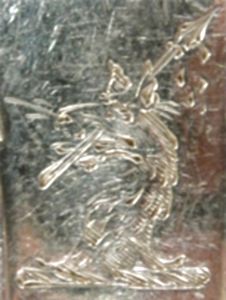
Each of the silver pieces up for sale
bears the Baskerville family crest
|
"Another earlier article in the Shropshire Star on May 7,
2008 provided a bit more information.
"Mr Heath described the discovery as "unbelievable" with the
Baskerville family crested silver dating back to the 1780s - the
earliest recorded for the family. The crest is on every piece of
the dinner service and shows a hound with a broken spear through
its jaw with five drips of blood falling from its tip. He added:
"I really don't know how these pieces have stayed hidden for
63 years. It is rare to find one piece of silver with the
Baskerville mark but finding 40 pieces is unheard of. There is a
strong connection between this silver and Arthur Conan Doyle’s
book."
David Hodby, current owner of Baskerville Hall Hotel, Clyro
Court in Hay on Wye, said: "The cutlery is not mine to sell
but a trader who visited here has them and I’m told they are
solid silver and in perfect condition, even though they are very
old. This is the original house of the Baskervilles and the same
family crest features throughout the hall’s stonework and in all
the gables. I didn't know about the cutlery and its discovery
came as a bit of a shock."
The hound on the crest is said to be "Black Vaughan" who, as
local legend has it, roamed the nearby moors of Hergest Ridge
and was the inspiration of Conan Doyle's book.
The crime writer is said to have written his most famous novel
at the Baskervilles' old home, which he stayed at often during
the late 19th and early 20th Century. The silver is believed to
have been used at the fine banquets Conan Doyle would have
attended during his numerous visits to the house in the late
19th and early 20th century."
With this added insight, our investigation now moved in a new
direction. Could our teapot & stand somehow be associated with
the Mynors-Baskervilles, Clyro Court, and the visits by Sir
Arthur Conan Doyle? All at once we could envision Sir Arthur
pouring an afternoon spot of tea from our pot as he sat back to
mull over Sherlock’s new mystery on the moors. We even went as
far as researching Sherlock's favorite brand of tea (FYI: it's
Lapsang Souchong, a smoky tea that is reminiscent of camp fires
... and briar pipes).
But at last sanity set in and logic began to once again prevail.
Comparing the crests on the teapot & stand with those on the
cutlery it was apparent they were virtually the same.
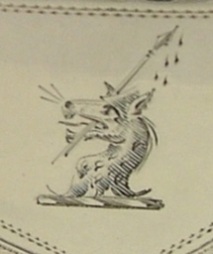
Teapot engraving
|
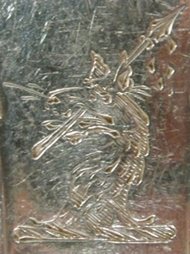
Baskerville cutlery engraving
(BBC Broadcast: Sunday,
1 June 2008 09:18 UK)
|
"We also discovered the same crest on a pair of silver
salvers offered by G. Cohen & Co. at the Silver Vaults in London
(www.gcohen.co.uk/salvers/pair-georgian-silver-salvers-sheffield-1817.html).
The salvers were made by S. Younge & Co. of Sheffield in 1817.
They are elaborately adorned with the marital arms of the
Baskerville and Hancock families and G. Cohen & Co. offers the
following description of their armorial engravings:
"These armorial bearings undoubtedly commemorate the marriage
of Thomas Baskerville Mynors-Baskerville, of Clyro Court in the
County of Herefordshire and Anne, daughter and heiress of John
Hancock, of Marlborough in the County of Wiltshire. They were
married in 1818 a year after the manufacture and hallmarking of
this particular pair of salvers. Thomas Baskerville
Mynors-Baskerville was born in April 1790, the son of Peter
Rickards-Mynors and Meliora Powell (whose maternal grandfather
through her mother, Philippa was Thomas Baskerville, of Aberelow
Court whose wife was Meliora, was in turn the eldest daughter of
Richard Baskerville, of Richardston). On the death of his cousin,
Thomas Baskerville (the grandson of Richard Baskerville) in
1817, Thomas Baskerville Mynors (as he was styled then)
succeeded to the family estates and assumed by Royal Licence,
the surname and arms of Baskerville. So we may assume that this
pair of salvers was purchased and engraved after this particular
event. Thomas Baskerville Mynors-Baskerville was a Justice of
the Peace and Deputy Lieutenant and served as Member of
Parliament for the County of Hereford. He also was High Sheriff
of Wiltshire for the year 1827. After the death of his wife,
Anne in 1832 (this marriage having no children), he married a
second time on the 2nd March 1837, Elizabeth Mary, eldest
daughter of the Rev. Powell Colchester Guise. This marriage
produced six children (three sons and three daughters). Thomas
Baskerville Mynors-Baskerville died on the 9th September 1864.
He was succeeded in the family estates by his eldest son, Walter
Thomas Mynors-Baskerville."
(For a more complete outline of the above refer to the
Baskerville family lineage at the end of this article)
The S. Younge & Co. salvers were made over twenty-five years
after the Clyro Court cutlery and our Chawner teapot & stand. So
the question arises as to whether Thomas B. Mynors-Baskerville
inherited the cutlery (and possibility the teapot) already
engraved with the crest, or did he have it added (after he
assumed the surname and arms) to un-engraved pieces he inherited
from his cousin? We feel it is unlikely Mynors-Baskerville
purchased 25-year old silver without any engraving and then had
his family crest added. His position and wealth would have
allowed him to have such serving pieces commissioned, as appears
was the case with the silver salvers mentioned above.
Since Thomas B. Mynors Baskerville inherited Colonel Thomas
Baskerville estate it is likely that this was where he obtained
the silver cutlery discovered at Clyro Court. Even though
Colonel Baskerville was married twice, he had no heirs. He did
have a sister, Meliora, who died unmarried in 1773, so it was
impossible for her to have ordered the silver pieces (they were
crafted in the 1780s).
Our research indicates that if the teapot was owned by Colonel
Thomas Baskerville, it might have been purchased when he took up
residence at Poulton House in Wiltshire around 1790. He was 59
at the time and we assume married to his second wife. The teapot
and stand might have been a part of his normal purchases of
household furnishings. Pulton House was built in 1706 and is
regarded as one of the premier Queen Anne homes in England.
Likely it will be impossible to ever determine that our Henry
Chawner teapot & stand were present at Clyro Court during the
time of Doyle’s visits. However it is possible they were at one
time a part of the same Baskerville family silver as the cutlery
pieces found at Clyro Court in 2008. This is based solely on the
closeness of their manufacture as well as the similarity of the
crests on the teapot & stand and the cutlery. Since Thomas B.
Mynors-Baskerville inherited both the Clyro Court property and
other Baskerville family belongings from his cousin, Colonel
Baskerville, the teapot & stand could have come along with the
cutlery. Since the silverware and teapot & stand were made in
the late 1780s and early 1790s, and the Colonel died in 1817,
there was a good chance they were still a part of his belongings
at the time of his death.
For fun, we purchased a copy of the USA, first-edition of Hound
of the Baskervilles (McClure, Phillips & Co., New York, 1902) to
accompany the teapot & stand. For us, passing by the combination
stimulates a vision of Sherlock Holmes being served tea from a
Baskerville family teapot -- the crest with the wolf, broken
spear, and five drops of blood reinforcing in his mind the
supposed family curse and the possibility of a murderous,
hound-like creature roaming the moors.
Joanne and Emmett Eldred
- 2012 -
|
|
|




